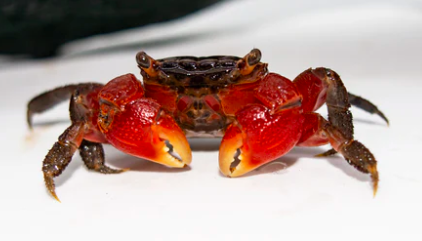 Image 1 of 1
Image 1 of 1


Crab- Purple Vampire
Purple Vampire Crabs (Geosesarma sp.), also known as Land Crabs, are fascinating and colorful crustaceans that are typically found in terrestrial environments rather than aquatic tanks. Here are their care requirements:
Habitat Requirements
Terrarium Setup: Provide a spacious terrarium with a land area and a small water area.
Substrate: Use a mix of soil, coconut fiber, and leaf litter to mimic their natural forest floor habitat.
Hiding Places: Offer plenty of hiding spots such as caves, driftwood, and plants.
Humidity: Maintain high humidity levels (around 70-80%) by misting the enclosure regularly.
Temperature and Lighting
Temperature: Keep the terrarium temperature around 75-85°F (24-29°C) during the day and slightly cooler at night.
Lighting: Provide a day-night cycle with low to moderate lighting. UVB lighting is not necessary but can be beneficial.
Water Requirements
Water Area: Include a small shallow water dish or pool with dechlorinated water. Ensure the water is not deep enough for them to drown.
Water Quality: Change the water regularly to prevent stagnation and maintain cleanliness.
Feeding
Diet: Purple Vampire Crabs are omnivorous scavengers.
Natural Diet: They feed on plant matter, small insects, algae, and decaying organic matter in their environment.
Feeding: Offer a varied diet including commercial crab or shrimp pellets, fish flakes, vegetables (e.g., spinach, zucchini), and occasional protein sources like mealworms or small crickets.
Behavior and Compatibility
Territorial: Purple Vampire Crabs can be territorial and may exhibit aggression towards each other, especially males.
Solitary or Small Groups: They are generally solitary but can be kept in small groups if provided with ample space and hiding spots.
Compatibility: Avoid housing them with other species, as they may be aggressive towards tank mates and are best kept alone or with their own kind.
Maintenance
Cleaning: Regularly clean and spot-clean the terrarium to remove waste and uneaten food.
Substrate Maintenance: Replace or refresh substrate as needed to maintain cleanliness and humidity levels.
Monitoring: Keep an eye on their behavior, appetite, and overall health. Look out for signs of stress or illness, such as lethargy or shell discoloration.
Additional Considerations
Handling: Avoid handling Purple Vampire Crabs excessively, as they can become stressed and may pinch.
Escape Prevention: Secure the terrarium with a tight-fitting lid to prevent escapes, as these crabs are good climbers.
Breeding: Breeding Purple Vampire Crabs in captivity is challenging and not commonly achieved due to their specific habitat and breeding requirements.
By providing a suitable terrarium setup with the right conditions and diet, Purple Vampire Crabs can thrive and display their vibrant colors and fascinating behaviors in captivity. Always research and understand their specific needs before bringing them into your care.
Purple Vampire Crabs (Geosesarma sp.), also known as Land Crabs, are fascinating and colorful crustaceans that are typically found in terrestrial environments rather than aquatic tanks. Here are their care requirements:
Habitat Requirements
Terrarium Setup: Provide a spacious terrarium with a land area and a small water area.
Substrate: Use a mix of soil, coconut fiber, and leaf litter to mimic their natural forest floor habitat.
Hiding Places: Offer plenty of hiding spots such as caves, driftwood, and plants.
Humidity: Maintain high humidity levels (around 70-80%) by misting the enclosure regularly.
Temperature and Lighting
Temperature: Keep the terrarium temperature around 75-85°F (24-29°C) during the day and slightly cooler at night.
Lighting: Provide a day-night cycle with low to moderate lighting. UVB lighting is not necessary but can be beneficial.
Water Requirements
Water Area: Include a small shallow water dish or pool with dechlorinated water. Ensure the water is not deep enough for them to drown.
Water Quality: Change the water regularly to prevent stagnation and maintain cleanliness.
Feeding
Diet: Purple Vampire Crabs are omnivorous scavengers.
Natural Diet: They feed on plant matter, small insects, algae, and decaying organic matter in their environment.
Feeding: Offer a varied diet including commercial crab or shrimp pellets, fish flakes, vegetables (e.g., spinach, zucchini), and occasional protein sources like mealworms or small crickets.
Behavior and Compatibility
Territorial: Purple Vampire Crabs can be territorial and may exhibit aggression towards each other, especially males.
Solitary or Small Groups: They are generally solitary but can be kept in small groups if provided with ample space and hiding spots.
Compatibility: Avoid housing them with other species, as they may be aggressive towards tank mates and are best kept alone or with their own kind.
Maintenance
Cleaning: Regularly clean and spot-clean the terrarium to remove waste and uneaten food.
Substrate Maintenance: Replace or refresh substrate as needed to maintain cleanliness and humidity levels.
Monitoring: Keep an eye on their behavior, appetite, and overall health. Look out for signs of stress or illness, such as lethargy or shell discoloration.
Additional Considerations
Handling: Avoid handling Purple Vampire Crabs excessively, as they can become stressed and may pinch.
Escape Prevention: Secure the terrarium with a tight-fitting lid to prevent escapes, as these crabs are good climbers.
Breeding: Breeding Purple Vampire Crabs in captivity is challenging and not commonly achieved due to their specific habitat and breeding requirements.
By providing a suitable terrarium setup with the right conditions and diet, Purple Vampire Crabs can thrive and display their vibrant colors and fascinating behaviors in captivity. Always research and understand their specific needs before bringing them into your care.



